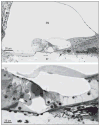Effect of apolactoferrin on experimental pneumococcal otitis media
- PMID: 21079169
- PMCID: PMC4022344
- DOI: 10.1001/archoto.2010.192
Effect of apolactoferrin on experimental pneumococcal otitis media
Abstract
Objective: To find the effect of apolactoferrin administration on the middle and inner ears after experimentally induced pneumococcal otitis media.
Design: Histopathologic and morphometric analysis of the middle and inner ears.
Setting: University of Minnesota, Minneapolis.
Subjects: Ten chinchillas.
Interventions: The middle ear cavities of chinchillas were inoculated bilaterally with type 2 wild-type Streptococcus pneumoniae. Twenty-four hours later, the ears of 5 of the animals were injected with phosphate-buffered saline (PBS) and the other 5 with human apolactoferrin. The animals were killed 24 hours after the last injection. Bacterial counts were made of the middle ear effusions, and the cochleae were processed for histologic analysis. The thickness of the round window membranes and bacterial and inflammatory cell infiltration of the round window membranes, and scala tympani and damage of the hair cells and stria vascularis were compared for these 2 groups of animals.
Main outcome measures: Comparison of inflammatory and bacterial cells in the middle and inner ears, and damage to inner ear structures.
Results: Bacterial plate counts of middle ear effusions (P = .005) and the number of inflammatory cells in the round window membrane (P = .047) were significantly lower in the apolactoferrin group compared with the group treated with PBS.
Conclusion: Further investigation of apolactoferrin as a nonantibiotic approach for the treatment of otitis media and its complications is needed to confirm its safety and efficacy.
Figures



Similar articles
-
The round window membrane in otitis media: effect of pneumococcal proteins.Arch Otolaryngol Head Neck Surg. 2008 Jun;134(6):658-62. doi: 10.1001/archotol.134.6.658. Arch Otolaryngol Head Neck Surg. 2008. PMID: 18559736
-
Viability and virulence of pneumolysin, pneumococcal surface protein A, and pneumolysin/pneumococcal surface protein A mutants in the ear.JAMA Otolaryngol Head Neck Surg. 2013 Sep;139(9):937-43. doi: 10.1001/jamaoto.2013.4104. JAMA Otolaryngol Head Neck Surg. 2013. PMID: 24051749 Free PMC article.
-
Virulence of pneumococcal proteins on the inner ear.Arch Otolaryngol Head Neck Surg. 2009 Jul;135(7):657-61. doi: 10.1001/archoto.2009.72. Arch Otolaryngol Head Neck Surg. 2009. PMID: 19620586
-
Otitis media: the chinchilla model.Microb Drug Resist. 1999 Spring;5(1):57-72. doi: 10.1089/mdr.1999.5.57. Microb Drug Resist. 1999. PMID: 10332723 Review.
-
Acute otitis media: management and surveillance in an era of pneumococcal resistance--a report from the Drug-resistant Streptococcus pneumoniae Therapeutic Working Group.Pediatr Infect Dis J. 1999 Jan;18(1):1-9. Pediatr Infect Dis J. 1999. PMID: 9951971 Review.
Cited by
-
Role of innate immunity in the pathogenesis of otitis media.Int J Infect Dis. 2014 Dec;29:259-67. doi: 10.1016/j.ijid.2014.10.015. Epub 2014 Nov 5. Int J Infect Dis. 2014. PMID: 25447732 Free PMC article. Review.
-
Three-Dimensional Analysis of Round Window Membrane in the Chinchilla Model with Acute Otitis Media Induced with Streptococcus Pneumoniae 7F.Turk Arch Otorhinolaryngol. 2021 Mar;59(1):43-48. doi: 10.4274/tao.2021.5998. Epub 2021 Mar 26. Turk Arch Otorhinolaryngol. 2021. PMID: 33912860 Free PMC article.
-
Panel 4: Recent advances in otitis media in molecular biology, biochemistry, genetics, and animal models.Otolaryngol Head Neck Surg. 2013 Apr;148(4 Suppl):E52-63. doi: 10.1177/0194599813479772. Otolaryngol Head Neck Surg. 2013. PMID: 23536532 Free PMC article. Review.
-
An in vitro model of murine middle ear epithelium.Dis Model Mech. 2016 Nov 1;9(11):1405-1417. doi: 10.1242/dmm.026658. Epub 2016 Sep 22. Dis Model Mech. 2016. PMID: 27660200 Free PMC article.
-
Relationship Between Cochlear Lateral Wall Changes and Endolymphatic Hydrops in Otitis Media.Laryngoscope. 2024 Dec;134(12):5103-5108. doi: 10.1002/lary.31626. Epub 2024 Jul 3. Laryngoscope. 2024. PMID: 38958129
References
-
- Teele DW, Klein JO, Rosner B. Epidemiology of otitis media during the first seven years of life in children in greater Boston: a prospective, cohort study. J Infect Dis. 1989;160(1):83–94. - PubMed
-
- Bergus GR, Levy SM, Kirchner HL, Warren JJ, Levy BT. A prospective study of antibiotic use and associated infections in young children. Paediatr Perinat Epidemiol. 2001;15(1):61–67. - PubMed
-
- Leibovitz E, Dagan R. Antibiotic treatment for acute otitis media. Int J Antimicrob Agents. 2000;15(3):169–177. - PubMed
-
- Lim DJ, Chun YM, Lee HY, et al. Cell biology of tubotympanum in relation to pathogenesis of otitis media: a review. Vaccine. 2000;19(1 suppl 1):S17–S25. - PubMed
-
- Schachern PA, Tsuprun V, Cureoglu S, et al. The round window membrane in otitis media: effect of pneumococcal proteins. Arch Otolaryngol Head Neck Surg. 2008;134(6):658–662. - PubMed
Publication types
MeSH terms
Substances
Grants and funding
LinkOut - more resources
Full Text Sources
Medical

